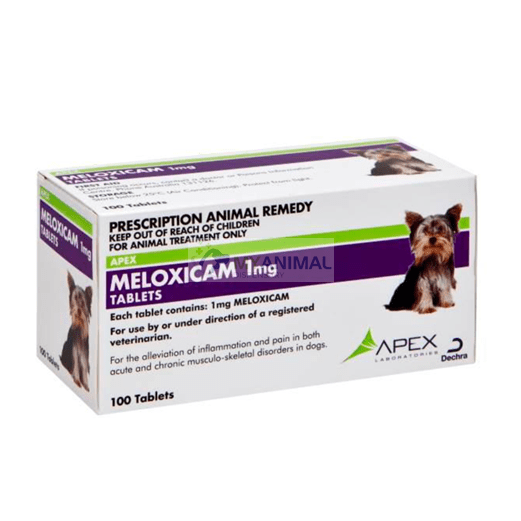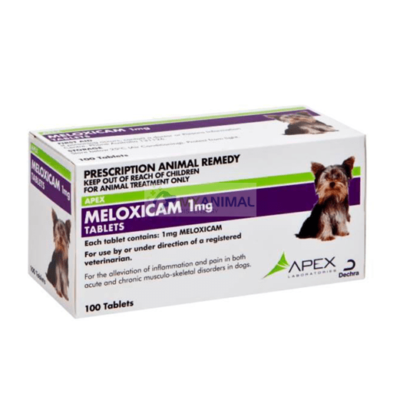
Meloxicam is a nonsteroidal anti-inflammatory drug (NSAID) commonly prescribed to help manage pain and inflammation in animals, particularly dogs and cats. Its effectiveness in treating various conditions that cause discomfort, such as arthritis, injuries, or post-surgical pain, makes it a vital tool in veterinary medicine. By understanding how Meloxicam works, its uses, potential side effects, and dosage guidelines, pet owners can make informed decisions to improve their pet’s quality of life.

What Is Meloxicam?
Meloxicam belongs to a class of drugs called NSAIDs, which are used to reduce inflammation, pain, and fever. It works by inhibiting the production of cyclooxygenase (COX) enzymes, particularly COX-2, which are involved in the inflammatory response. By blocking these enzymes, Meloxicam helps to reduce swelling, pain, and discomfort in affected tissues. Unlike other NSAIDs, Meloxicam selectively targets COX-2, which helps minimize gastrointestinal side effects, making it safer for long-term use in animals.
In veterinary medicine, Meloxicam is often used for conditions such as:
- Osteoarthritis: Chronic inflammation of the joints causing pain and stiffness.
- Post-surgical pain: Discomfort following surgery, especially orthopedic procedures.
- Injuries: Sprains, strains, or fractures that cause acute pain and swelling.
- Soft tissue inflammation: Conditions like tendonitis or muscle inflammation.
How Does Meloxicam Work for Pets?
When a pet experiences pain, the body releases chemicals called prostaglandins, which play a key role in promoting inflammation and triggering pain signals to the brain. Meloxicam works by inhibiting the enzyme cyclooxygenase (COX), which is responsible for producing these prostaglandins. Specifically, Meloxicam targets COX-2, a form of the enzyme that is more active during inflammation and injury.
By blocking COX-2, Meloxicam reduces the production of prostaglandins, leading to decreased inflammation, pain, and swelling. This not only helps to relieve your pet’s immediate discomfort but also promotes healing by reducing the overall strain on their body due to inflammation.
Common Uses of Meloxicam in Pets
1. Osteoarthritis Management
Osteoarthritis is a degenerative joint disease that affects older pets, particularly dogs. It causes chronic pain, stiffness, and reduced mobility. Meloxicam can significantly improve a pet’s ability to move and play by reducing inflammation in the joints and alleviating pain. It is often used as part of a long-term pain management plan for pets suffering from arthritis.
2. Post-Surgical Pain Relief
After surgery, pets can experience significant pain and inflammation. Whether it’s orthopedic surgery, soft tissue surgery, or dental work, Meloxicam is often prescribed to manage post-operative discomfort and speed up recovery.
3. Injury and Trauma
Injuries like sprains, strains, or fractures often lead to swelling and pain. Meloxicam helps reduce these symptoms, making recovery more comfortable for your pet.
4. Inflammatory Conditions
Pets may develop soft tissue inflammation due to various reasons, including tendonitis or muscle injuries. Meloxicam can help reduce the inflammation and alleviate the associated pain.
Benefits of Meloxicam for Pets
- Effective Pain Relief: Meloxicam is highly effective at reducing both acute and chronic pain, which is crucial for improving your pet’s quality of life.
- Long-Term Management: For chronic conditions like arthritis, Meloxicam can be used as part of a long-term treatment plan to keep pain and inflammation under control.
- Reduced Side Effects: Compared to other NSAIDs, Meloxicam generally has a lower risk of causing gastrointestinal issues, making it safer for long-term use in pets.
- Improved Mobility: By easing pain and reducing inflammation, Meloxicam can help pets regain mobility and enjoy a more active lifestyle.
Potential Side Effects of Meloxicam
While Meloxicam can be highly effective, like all medications, it does carry potential side effects. Some pets may experience mild side effects, while others may have more severe reactions. The most common side effects of Meloxicam in pets include:
- Gastrointestinal issues: Vomiting, diarrhea, loss of appetite, or stomach ulcers.
- Kidney problems: Meloxicam can affect kidney function, especially in pets with pre-existing kidney issues. Dehydration can exacerbate this effect.
- Liver issues: Rarely, Meloxicam may cause liver problems, which can be detected through blood tests.
- Changes in behavior: Some pets may become more lethargic or irritable.
- Allergic reactions: Signs may include swelling, itching, or difficulty breathing.
To reduce the risk of side effects, it’s important to follow your veterinarian’s instructions closely. Blood tests may be recommended before starting treatment to check for any pre-existing kidney or liver conditions, and periodic check-ups are often recommended during treatment.
Dosage and Administration
The correct dosage of Meloxicam for your pet will depend on several factors, including their species, weight, age, and the condition being treated. The medication is typically available in oral tablets, liquid suspension, or injectable form.
- Initial dosage: For most pets, the typical initial dosage is higher than the maintenance dosage to quickly reduce pain and inflammation. For example, dogs may start with 0.2 mg per kg of body weight on the first day.
- Maintenance dosage: After the initial dose, the daily dosage is usually reduced to around 0.1 mg per kg of body weight for ongoing treatment.
The veterinarian will determine the appropriate dose based on your pet’s needs, and it’s essential to adhere strictly to the prescribed amount and schedule.
Meloxicam is usually taken with food to reduce the risk of stomach upset. Always ensure your pet has access to fresh water while they are on this medication, and never exceed the prescribed dose.
Important Considerations and Warnings
- Do not give to cats without veterinary supervision: While Meloxicam is safe for most dogs, it can be toxic to cats, especially if not administered properly. Only a veterinarian can determine if it is suitable for your cat.
- Monitor for side effects: If your pet shows signs of gastrointestinal distress, lethargy, or behavioral changes, contact your vet immediately.
- Not for pets with certain conditions: Meloxicam should not be used in pets with known kidney, liver, or gastrointestinal problems unless specifically prescribed by a veterinarian.
READ ALSO: How Long Does a Cat Stay Pregnant?
FAQs
Can Meloxicam be given to cats?
Meloxicam can be prescribed to cats under specific conditions by a veterinarian. However, it is not typically recommended for long-term use in cats due to the potential for serious side effects. Always follow your vet’s guidance regarding dosage and duration.
How long does it take for Meloxicam to work in pets?
Most pets will start to show improvement in pain and mobility within 1-3 days of starting Meloxicam. However, full effects may take up to a week, depending on the severity of the condition.
What should I do if I miss a dose?
If you miss a dose of Meloxicam, give it as soon as you remember. However, if it’s almost time for the next dose, skip the missed dose and continue with the regular schedule. Never give a double dose to make up for a missed one.
Can Meloxicam be used long-term?
Meloxicam can be used long-term under the supervision of a veterinarian, particularly for managing chronic pain associated with conditions like arthritis. Regular veterinary check-ups and blood tests are important to monitor for any side effects.
Are there any alternative treatments to Meloxicam for pets?
Yes, there are several alternatives, including other NSAIDs like carprofen or deracoxib, and non-pharmaceutical approaches like physical therapy, acupuncture, or joint supplements (e.g., glucosamine and chondroitin). Your vet will recommend the best option based on your pet’s specific needs.
Leave a Reply
You must be logged in to post a comment.